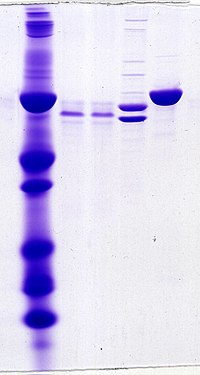
Photo from wikipedia
The interior lumen of acidic organelles (e.g., endosomes, secretory granules, lysosomes and plant vacuoles) is an important platform for modification, transport and degradation of biomolecules as well as signal transduction,… Click to show full abstract
The interior lumen of acidic organelles (e.g., endosomes, secretory granules, lysosomes and plant vacuoles) is an important platform for modification, transport and degradation of biomolecules as well as signal transduction, which remains challenging to investigate using conventional fluorescent proteins (FPs). Due to the highly acidic luminal environment (pH ~ 4.5–6.0), most FPs and related sensors are apt to lose their fluorescence. To address the need to image in acidic environments, several research groups have developed acid-tolerant FPs in a wide color range. Furthermore, the engineering of pH insensitive sensors, and their concomitant use with pH sensitive sensors for the purpose of pH-calibration has enabled characterization of the role of luminal ions. In this short review, we summarize the recent development of acid-tolerant FPs and related functional sensors and discuss the future prospects for this field.
Journal Title: International Journal of Molecular Sciences
Year Published: 2018
Link to full text (if available)
Share on Social Media: Sign Up to like & get
recommendations!